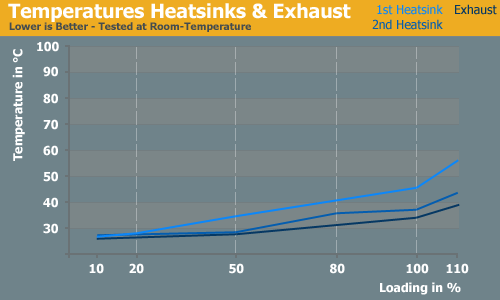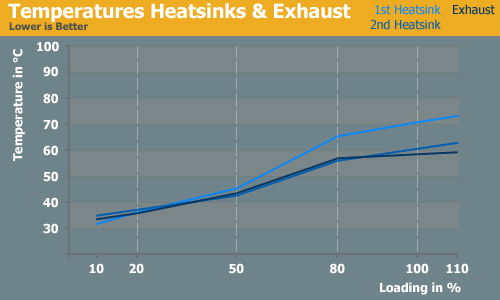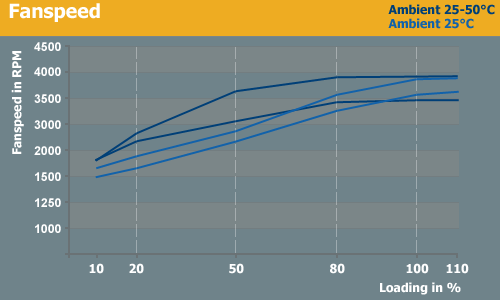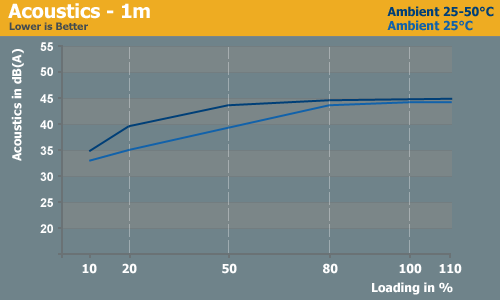Ultra High-End PSU Roundup
by Christoph Katzer on October 22, 2007 6:00 AM EST- Posted in
- Cases/Cooling/PSUs
Tagan ITZ 1300W Efficiency, Temperatures, Fan Speed and Acoustics

The efficiency is similar to what we have seen from the other two power supplies. The difference we can see here is the nicely even curve which is constantly above 80% with any load above 260W, with a slight drop near the 100% load mark.


The temperatures increase slowly during room temperature testing which is a good sign for a well arranged airflow. Just with overload the temperature is suddenly making a big step of over 10°C within a few minutes. Under the hotter heat chamber conditions the temperature begins to increase at medium load and beyond. Naturally, the fans are also spinning faster at this point, but they are nearing their limit. The temperature of both heat sinks mostly stabilizes by 80% load, beyond which point heat is only increasing slowly.


The push-pull fan configuration is quite effective, and having a more powerful fan on the exhaust also works quite well. In this way there is a kind of vacuum established which lets air come in through the venting holes on the side. The result is that the components are cooler but this kind of power supply still gets very hot and needs proper airflow to function. This can only be done with high speed fans, and with up to 4000 RPM this might be enough. Also with this power supply we see the full speed already reached at half of the full load while in the heat chamber. Under room temperature conditions the fan is steadily spinning faster and only reaches maximum RPM at full load. It's again clear that the amount of airflow necessary to cool a 1300W power supply cannot be achieved without producing noise, and therefore we see up to 45dB(A) under hot conditions. With low speeds at lower loads you can still hear the fan quite easily, but in a PC system this noise will not be as audible as when we had it open and running in front of us.

The efficiency is similar to what we have seen from the other two power supplies. The difference we can see here is the nicely even curve which is constantly above 80% with any load above 260W, with a slight drop near the 100% load mark.


The temperatures increase slowly during room temperature testing which is a good sign for a well arranged airflow. Just with overload the temperature is suddenly making a big step of over 10°C within a few minutes. Under the hotter heat chamber conditions the temperature begins to increase at medium load and beyond. Naturally, the fans are also spinning faster at this point, but they are nearing their limit. The temperature of both heat sinks mostly stabilizes by 80% load, beyond which point heat is only increasing slowly.


The push-pull fan configuration is quite effective, and having a more powerful fan on the exhaust also works quite well. In this way there is a kind of vacuum established which lets air come in through the venting holes on the side. The result is that the components are cooler but this kind of power supply still gets very hot and needs proper airflow to function. This can only be done with high speed fans, and with up to 4000 RPM this might be enough. Also with this power supply we see the full speed already reached at half of the full load while in the heat chamber. Under room temperature conditions the fan is steadily spinning faster and only reaches maximum RPM at full load. It's again clear that the amount of airflow necessary to cool a 1300W power supply cannot be achieved without producing noise, and therefore we see up to 45dB(A) under hot conditions. With low speeds at lower loads you can still hear the fan quite easily, but in a PC system this noise will not be as audible as when we had it open and running in front of us.










27 Comments
View All Comments
redly1 - Monday, October 22, 2007 - link
I'm just trying to imagine the flames that ensue when something goes bad on the motherboard.Anyone ever burn up a classic Athlon by forgetting to put the heatsink on? Imagine doing that with a 1.3kW supply? Yikes
billa16 - Tuesday, October 23, 2007 - link
I did that on a k7@950. I was trying to oc it(hardmod with a pencil). Nothing happend the first 2 times(just a few secs). After that it's stopped working. No sparks/flames and stuff like that. Don't belive anything U read/see on the internet.This type of power supply's have protections. If something is damaged so bad that would cause flames the protection kicks in. The worst fire scenario with this type of PSU will be a flash when the fuse burns out.
Sorry for my poor english.
DigitalFreak - Monday, October 22, 2007 - link
Still amazes me how many people fall for the marketing hype...Traciatim - Monday, October 22, 2007 - link
Instead of just giving specs and doing an overview of the efficiency, why not design a machine that actually needs these over say a 600-700Watt PSU and show watt you would need to do do actually use one of these.I have a pretty small machine, and it regularly pulls 120Watts out of the wall, 200Watts if I Get everything ramped up. I'm also using a P4, not a Core2Duo so it's not going to be as efficient.
The ONLY point that I can see to have one of these is simply to waste money on uneeded equipment that could be better spent one something performance based and to say that 'My PSU is bigger than your PSU'.
retrospooty - Monday, October 22, 2007 - link
Ya, these 1000+ watt PSU's are marketed to enthusiests, and are supposed to be for heavily overclocked quad core CPU's (meaning cascade, dry ICE or liquid nitrogen cooling kind of overclocks) with overclocked high end SLI or crossfire rigs, and plenty of hard drives and other peripherals added as well. We are talking $3000 or higher systems - WAY overkill probably even for that purpose.JarredWalton - Monday, October 22, 2007 - link
You can see the most power-hungry system I've personally tested http://www.anandtech.com/systems/showdoc.aspx?i=30...">right here - which uses standard ATX components and a Topower PSU. That's a lot more system than most people run, obviously, but if maximum efficiency is achieved in the 40-80% load range, and if that particular PSU was around 80% efficient, it was outputting around 600W of power at maximum load.Toss in TriFire HD 2900 XT and you could add another 100W to that, maybe. If you were to get an overclocked Xeon platform with dual quad-core CPUs plus CrossFire/TriFire, you could actually reach the point where 1300W was "required". LOL
ORB chasers and "professional benchmarkers" running at insane overclocks (i.e. 5000 MHz quad-core) deal with exponential power requirement increases as well. The solution is either to use multiple PSUs or else get one of these uber-powerful designs. So these appear to be for around 0.01% of the market, I guess?
Michael91ah - Monday, October 22, 2007 - link
Glad to see the statistics for these 3 units. I really like the Cooler Master's curve on the acoustics. That noise makes a big difference for me when choosing a power supply.